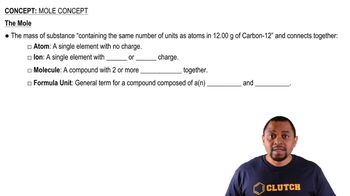If an Avogadro’s number of pennies is divided equally among the 321 million men, women, and children in the United States, how many dollars would each receive? How does this compare with the gross domestic product (GDP) of the United States, which was $21.4 trillion in 2019? (GDP is the total market value of the nation’s goods and services.)
Ch.3 - Chemical Reactions and Reaction Stoichiometry
Chapter 3, Problem 35d
Calculate the following quantities: (d) number of N atoms in 0.410 mol NH3
 Verified step by step guidance
Verified step by step guidance1
Identify the chemical formula of ammonia (NH_3), which contains one nitrogen (N) atom per molecule.
Recognize that the number of moles of a substance is directly proportional to the number of molecules or atoms it contains.
Use Avogadro's number (6.022 \times 10^{23} mol^{-1}) to convert moles of NH_3 to molecules of NH_3.
Since each molecule of NH_3 contains one nitrogen atom, the number of nitrogen atoms is equal to the number of NH_3 molecules.
Multiply the number of moles of NH_3 (0.410 mol) by Avogadro's number to find the number of nitrogen atoms.

Verified video answer for a similar problem:
This video solution was recommended by our tutors as helpful for the problem above.
Video duration:
1mWas this helpful?
Key Concepts
Here are the essential concepts you must grasp in order to answer the question correctly.
Mole Concept
The mole is a fundamental unit in chemistry that quantifies the amount of substance. One mole contains approximately 6.022 x 10²³ entities, such as atoms or molecules. This concept allows chemists to convert between the mass of a substance and the number of particles it contains, facilitating calculations in stoichiometry.
Recommended video:
Guided course

Mole Concept
Chemical Formula
A chemical formula represents the composition of a compound, indicating the types and numbers of atoms present. For ammonia (NH₃), the formula shows that each molecule contains one nitrogen atom and three hydrogen atoms. Understanding chemical formulas is essential for determining the number of specific atoms in a given amount of substance.
Recommended video:
Guided course

Skeletal Formula
Stoichiometry
Stoichiometry is the area of chemistry that deals with the relationships between the quantities of reactants and products in chemical reactions. It allows for the calculation of the number of atoms, molecules, or moles of a substance based on the balanced chemical equation. In this case, stoichiometry helps determine the number of nitrogen atoms in a specified amount of ammonia.
Recommended video:
Guided course

Stoichiometry Concept
Related Practice
Textbook Question
Textbook Question
Calculate the following quantities: (a) mass, in grams, of 0.105 mol sucrose (C12H22O11)
Textbook Question
Calculate the following quantities: (c) number of molecules in 1.0⨉10−6 mol CH3CH2OH
Textbook Question
Calculate the following quantities: (a) mass, in grams, of 1.50⨉10−2 mol CdS
Textbook Question
Calculate the following quantities: (b) number of moles of NH4Cl in 86.6 g of this substance
Textbook Question
Calculate the following quantities: (c) number of molecules in 8.447⨉10−2 mol C6H6
